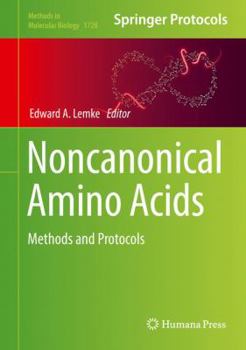Noncanonical Amino Acids: Methods and Protocols
(Book #1728 in the Methods in Molecular Biology Series)
Select Format
Select Condition 
Book Overview
Part I: Engeneering in the Test Tube
1. Leveraging Formylglycine-Generating Enzyme for Production of Site-Specifically Modified Bioconjugates
Robyn M. Barfield and David Rabuka
2. Artificial Division of Codon Boxes for Expansion of the Amino Acid Repertoire of Ribosomal Polypeptide Synthesis
Yoshihiko Iwane, Takayuki Katoh, Yuki Goto, and Hiroaki Suga
3. Cell-free Protein Synthesis for Multiple Site-Specific Incorporation of Noncanonical Amino Acids Using Cell Extracts from RF-1 deletion E. coli Strains
Eiko Seki, Tatsuo Yanagisawa, and Shigeyuki Yokoyama
4. Tub-tag Labeling; Chemoenzymatic Incorporation of Unnatural Amino Acids
Jonas Helma, Heinrich Leonhardt, Christian P.R. Hackenberger, and Dominik Schumacher
Part II: Engeering in Prokaryotes
5. Directed Evolution of Orthogonal Pyrrolysyl-tRNA Synthetases in Escherichia coli for the Genetic Encoding of Noncanonical Amino Acids
Moritz J. Schmidt and Daniel Summerer
6. Genetic Code Expansion in Enteric Bacterial Pathogens
Huangtao Zheng, Shixian Lin, and Peng R. Chen
7. Self-directed in Cell Production of Methionine Analogue Azidohomoalanine by Synthetic Metabolism and its Incorporation into Model ProteinsYing Ma, Martino Luigi di Salvo, and Nediljko Budisa
8. Residue-specific Incorporation of no Canonical Amino Acids for Protein Engineering
Mark B. van Eldijk and Jan C.M. van Hest
9. Using Amber and Ochre Nonsense Codons to Code Two Different Noncanonical Amino Acids in One Protein GeneJeffery M. Tharp and Wenshe R. Liu
10. Genetic Incorporation of Unnatural Amino Acids into Proteins of Interest in Streptomyces venezuelae ATCC 15439
Jingxuan He and Charles E. Melan?on III
11. Expression and Purification of Site-specifically Lysine-acetylated and Natively-folded Proteins for Biophysical Investigations
Michael Lammers12. Site-specific Incorporation of Sulfotyrosine Using an Expanded Genetic Code
Xiang Li and Chang C. Liu
13. Site-specific Protein Labeling With Tetrazine Amino Acids
Robert J. Blizzard, True E. Gibson, and Ryan A. Mehl
Part III: Engineering in Eukaryotes
14. Mapping of Protein Interfaces in Live Cells Using Genetically Encoded Crosslinkers
Lisa Seidel and Irene Coin
15. Generation of Stable Amber Suppression Cell LinesSimon J Els?sser
16. Trapping Chromatin Interacting Proteins with Genetically Encoded, UV-Activatable Crosslinkers In Vivo
Christian Hoffmann, Heinz Neumann, and Petra Neumann-Staubitz17. Genetically Encoding Unnatural Amino Acids in Neurons in vitro and in the Embryonic Mouse Brain for Optical Control of Neuronal Proteins
Ji-Yong Kang, Daichi Kawaguchi, and Lei Wang
18. Genetic Code Expansion-and Click Chemistry-Based Site--Specific Protein Labelling For Intracellular DNA--PAINT Imaging
Ivana Nikic
19. MultiBacTAG- Genetic Code Expansion using the Baculovirus Expression System in Sf21 Cells
Christine Koehler and Edward A. Lemke
20. Production and Chemoselective Modification of Adeno-associated Virus Site-specifically Incorporating an Unnatural Amino Acid Residue into its Capsid
Rachel E. Kelemen, Sarah B. Erickson, and Abhishek Chatterjee
21. Generation of Intramolecular FRET Probes via Noncanonical Amino Acid Mutagenesis
Simone Brand and Yao-Wen Wu
22. Fluorogenic Tetrazine--siliconrhodamine Probe for the Labeling of Non-canonical Amino Acid Tagged Proteins
Eszter Kozma, Giulia Paci, Gemma Estrada Girona, Edward A. Lemke, and P?ter Kele
23. Site-specific Protein Labeling Utilizing Lipoic Acid Ligase (LplA) and Bioorthogonal Inverse Electron Demand Diels-Alder Reaction
Mathis Baalmann, Marcel Best, and Richard Wombacher





